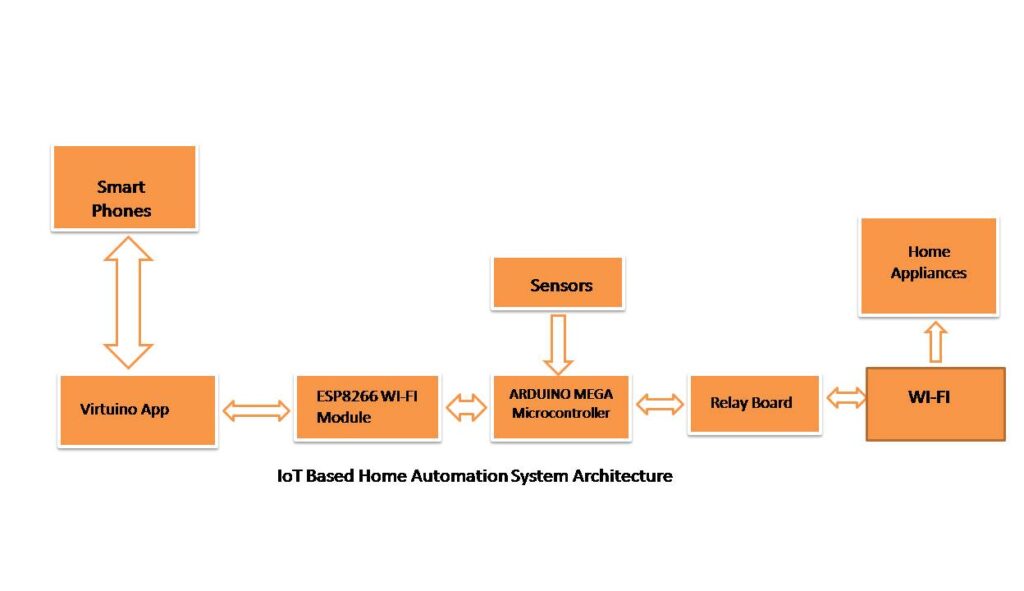IoT has been a trend for many years and is being fastest-growing as the next industrial revolution. The initial estimations of the number of a connected devices with the IoT were in the range of 49.5 billion by 2020. This estimation has been refined to closer 36-41 billion.
IoT has started to move into other domains like “connect to unconnected”. There is a vision to connect those industries where IoT has been not deployed with automation.
Before, focus on the challenges of IoT in smart home automation; let’s see the system architecture of smart home automation using IoT.

The system architecture of smart home automation using IoT consists of ESP8266 WI-FI module, Virtuino App, Arduino Mega Microcontroller, sensors, and relay board. The system architecture is shown in the figure.
Let’s see the main components used in smart home automation and how it works.
Arduino: The Arduino mega is used as the main controller in smart home automation. It is a less expensive, cross-platform, clear programming environment, and open source. The electrical appliances and the sensors are connected to the Arduino Mega. The function of the Arduino board is to read the input and convert it into output. Also, it receives and transmits serial data, triggers an interrupt on a low value, and provides 8-bit PWM output.
WI-FI module ESP8266: Wi-Fi Module ESP8266 has 8 pins. It is connected to the Arduino Mega. This module is compatible with the 3.2V logic level only. ESP8266 is chosen because it is affordable and offers more features. This makes it an ideal module for IoT applications.
The local control system over Wi-Fi and remote control is established based on the Internet of things. The suitable Wi-Fi-based android application is Virtuino and it is used. It has a user-friendly interface. It can work efficiently with Arduino Mega to control and monitor via Smartphone. The Arduino controller is programmed to interact with the Virtuino application. The Wi-Fi module and sensors will be connected directly to the Arduino Mega microcontroller. The sensors have represented the inputs of the microcontroller. The relay board receives its input signals from Arduino Mega. The relay board is connected to the WI-FI module. Using the WI-FI module, we can easily establish a wireless connection. The home appliances are connected through the WI-FI module to operate and control.
Challenges of IoT in smart home Automation: There are some challenges of IoT in smart home automation. They are mentioned below.
Data Security and Latency: Data security and latency are big issues in smart home automation. To enhance data security, use the IEEE standard protocol. To overcome the latency issues, the use of fog computing is a resolution.
Mixed criticality: The use of different systems and functions in smart home automation the different criticalities raise. To overcome mixed-criticality, separate the low-criticalities functions and high criticality functions.
Fault Tolerance: Hundreds of sensors interfaced with hardware and software in the smart home automation system. Hence, it is difficult to find fault in the system when it occurs. To counter the occurred fault in the system, use redundant controllers.
Functional safety: Functional safety like fire system or emergency system should be on priority. It should be working consistently. To overcome this challenge, build a separate IoT-based emergency system.
The smart home automation using IoT has the potential to connect multiple unconnected devices. IoT innovation has changed the way people interact. In this era, IoT automation is in trend.



